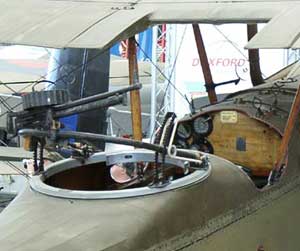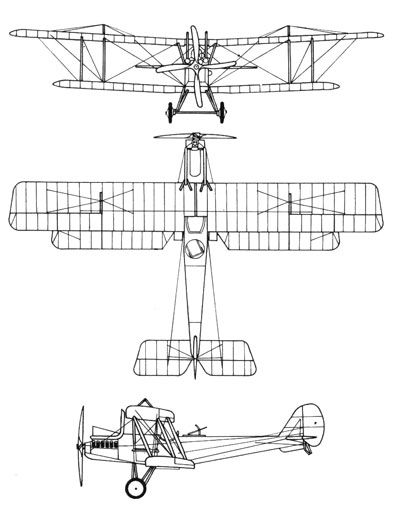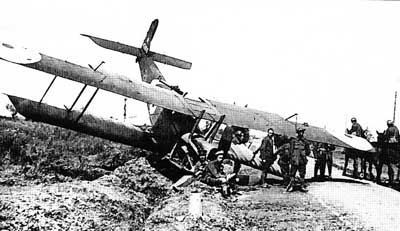Royal Aircraft Factory R.E.8 WWI British Reconnaissance/Bomber

A stately and stable observation and photo-reconnaissance platform, the RAF RE.8 was designed to replace the slow and vulnerable BE.2 with an aircraft of superior performance and armament. The actual improvements were marginal, but at least the observer was now located in the seat with a view. The RE.8 rarely achieved anything like its stated top speed. The difference between the actual combat speed and the stalling speed was only about 20mph. Maneuvers had to be made carefully so as not to fall into a deadly spin. The high stalling speed also made landings difficult and dangerous. The armament was useless for either offence or defense. RE.8s fell in great numbers to German fighters. Manfred von Richthofen, the 'Red Baron', shot down seven of them, but didn't regard them as much sport.
The vulnerability of the RE.8 meant that single reconnaissance machines needed a strong fighter escort, which diverted the fighter squadrons from their primary mission of seeking and destroying the enemy. It came as a considerable relief to the British aircrews when the RE.8 observation squadrons began to re-equip with a new type, the Armstrong Whitworth FK.8, in 1917. The FK.8 was sturdy and well able to defend itself, as many German fighter pilots found to their cost.
RAF RE.8

On the Allied side, the autumn of 1916 saw the entry into service of the aircraft which was the most widely used British twin-seater on the Western front: the R.A.F. R.E.8. This rapidly acquired the rhyming nickname Harry Tate. 4,099 of them were built. a remarkable number for those days, and this biplane whilst not exceptional (mainly because of unsatisfactory maneuverability which made it vulnerable to enemy fighters) was generally good enough to remain in service in all operational theatres until the Armistice. After its original role of reconnaissance plane, the R.E.8 was soon used as a day and night bomber, and for army co-operation and ground attack.
The project, which was started off towards the end of 1915, was dictated by the necessity of replacing the B.E.2c which was insufficiently armed and not very manoeuvrable. The first prototype flew on 17th June 1916 and production commenced in August.
The aircraft did show some improvement where armament was concerned, but its maneuverability was really quite poor and similar to that of the machine which it was supposed to replace. In spite of this the R.E.8 went into service and once it had gone through an initial phase of structural alterations which led to considerable changes in the tail plane, it soon went to sixteen reconnaissance squadrons.
 Of the 4,099 manufactured, 22 were supplied to the Belgian air force, who used them after replacing the engines. Apart from serving on the Western front. the R.A.F. R.E.8 was used by two British squadrons in Italy, two in Mesopotamia, two in Palestine, and three Home Defense squadrons.
Of the 4,099 manufactured, 22 were supplied to the Belgian air force, who used them after replacing the engines. Apart from serving on the Western front. the R.A.F. R.E.8 was used by two British squadrons in Italy, two in Mesopotamia, two in Palestine, and three Home Defense squadrons.
The Royal Aircraft Factory R.E.8 was a British two-seat biplane reconnaissance and bomber aircraft of the First World War. Intended as a replacement for the vulnerable B.E.2, the R.E.8 was much more difficult to fly, and was regarded with great suspicion at first in the Royal Flying Corps. Although eventually it gave reasonably satisfactory service, it was never an outstanding combat aircraft. In spite of this, the R.E.8 served as the standard British reconnaissance and artillery spotting aircraft from mid-1917 to the end of the war, serving alongside the rather more popular Armstrong Whitworth F.K.8. Over 4,000 R.E.8s were eventually produced and they served in most theatres including Italy, Russia, Palestine and Mesopotamia, as well as the Western Front.
The first of two prototype R.E.8s (Reconnaissance Experimental 8) flew on June 17, 1916. The new type was specifically designed to overcome the drawbacks of the B.E.2 - it had a more powerful motor, giving an improved performance, in particular a heavier payload. It was also much better armed, with a synchronized forward-firing .303-in Vickers machine gun and one or two Lewis guns on a Scarff ring in the observer's cockpit. It was (intentionally) less stable than the B.E.2, although modifications had to be made to improve stability before it could gain acceptance by pilots used to the B.E.2e - making the production version a good platform for artillery spotting but giving it little chance of outmaneuvering enemy fighters.
Most R.E.8s were powered by the 150 hp Royal Aircraft Factory 4a air-cooled 12-cylinder inline engine though some received the 200 hp RAF 4d engine and others had an Hispano-Suiza engine. A supply shortage of Hispano-Suiza engines, as well as the Rolls-Royce aero engines, such as the Falcon, prevented any upgrade of the R.E.8's powerplant. The engine was installed so that the propeller inclined upwards to improve the takeoff and landing run. This produced a "broken back" appearance to the fuselage, and an illusion that the tail sloped upwards. As with most RAF engine installations, the twin exhausts protruded over the upper wing to carry the fumes clear of the crew. As with the B.E.2e, the long extensions on the upper wing were reputed to be liable to collapse if the aircraft was dived too sharply.

 |
Royal Aircraft Factory R.E.8 Cockpits. |
Specifications of the RAF RE.8
 |
Crew: 2 (pilot & observer/gunner) Length: 27 ft 10 in Wingspan: 42 ft 7 in Height: 11 ft 4 in Wing area: 389 sq ft Empty weight: 1,577 lb Max takeoff weight: 2,862 lb Powerplant: 1× Royal Aircraft Factory 4a air-cooled 12-cylinder inline engine, 150 hp Performance Maximum speed: 102 mph Service ceiling: 13,500 ft Rate of climb: 22 minutes to 10,000 ft Armament 1 x .303 in (7.7 mm) forward-firing Vickers gun 1 or 2 x .303 in (7.7 mm) Lewis guns in rear cockpit up to 224 lb bombs |
 |
|||
| A: The RE.8 had a forward-firing machine gun set at an angle so the pilot could fire it, but where the bullets would miss the propeller. This made hitting an opponent almost impossible. | B: At least on early model RE.8s the observer could not turn around in his seat or fire the rear gun from a standing position, so he had to somehow aim and fire it over his shoulder. | C: As well as operating on the Western Front, RE.8s saw action in the Balkans and the Middle East. | D: The tendency to spin was reduced by fitting a ventral fin at the base of the tail. This further reduced what little agility the RE.8 had. |


